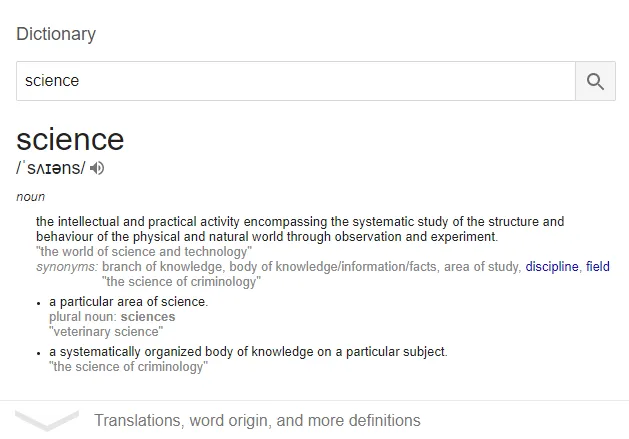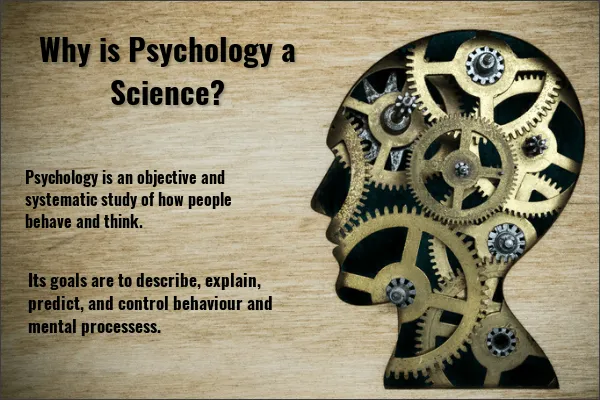
This is a question I have encountered quite a few times over the period I’ve been here on Steemit. While I am open to debate, the arguments put forward by those who are reluctant to accept psychology as a science make me cringe a little bit! And this is precisely when I ask myself why don’t people ask?Instead of just blurting out their opinions.
So, when pacing up and down while trying to find a way to demonstrate some of the aspects that make psychology a science, I thought that it would be sensible to start with the very denotative definition of the word science. A minute later, there I was googling: meaning of science.

The search result could not have been better for two reasons:
- it helped me to improve my own definition of the word,
- it helped me to plan my post!
How? Well, can you think of anything that makes us think of science other than experiments? You hear the word experiment, you immediately think: Science! So, I was in luck because I love, love, love experiments. As much as I appreciate case studies, ethnographical approaches, content analyses (which all, by the way, constitute the systematic study mentioned on the definition above) etc... for me, reading experimental research is as enjoyable as reading a good classic novel! Whether it is a between-participant or within-participant experiment, or with animals ... I don’t mind. Bring it on! Although, truth to be told, some of the animal experiments conducted up to the 60’s, 70’s can be heart breaking (Harry Hallow’s research with Rhesus Macaques back in the 50’s is an example).
So, for those who believe psychology is just a statistical bunch of data, a collection of contradictory theories, a conspiracy, or ... not a science; here we go.
A brief description of some of my favourite psychological laboratory studies/experiments.
Can you get more ‘sciency’ than this?
But then, of course, I don’t want just to list my top psychological experiments (this would be a quite long list). I want more! And this is because whenever studying such kind of research, psychologists have to keep ecological validity in mind, which is:
The extent to which a study reflects naturally occurring or everyday situations
Consequently, this post will proceed addressing how laboratory research, in the field of psychology, has contributed to the understanding of human behavior.
So, let’s embark on this rather long post step by step. For those of you who are out of touch with what psychological studies are all about. Here it is a brief explanation!
What are the aims of psychological studies/experiments?
Well, psychological studies seek to understand what underlies people’s behaviour and experiences. And one way of doing this is through research conducted in laboratories! This is a fascinating mode of research because here psychologists are able to isolate and manipulate determiners of responses in order to gather insight into what drives humans to interact with and react to their environment the way they do.
Experiment 1 – Exploring the role ‘consequences’ have on strengthening and eliminating behaviour, through the Skinner Box Experiment

Have you ever found yourself repeating (or, halting for that matter) a certain behaviour because of what happened afterwards? This is what this study explores/explains.
This laboratory experiment was carried out by a behaviourist psychologist (B.F Skinner) back in the 30’s. It contributed to uncover some of the underlying factors that cause humans to initiate, sustain and change their behaviour. This research enlightened this idea through showcasing the ways which behaviour can be determined by its results, by its consequences.
So, once upon a time Skinner created the Skinner box, an object that enabled him to shape the responses of rats and pigeons to subsequently obtain a certain type of behaviour from the animals. Reinforcement (the equivalent of an award or lack of it) was the process used to induce and measure the rate at which the desired behaviour took place, and punishment was the method adopted to lower the frequency of a given action. Behaviourist psychologists called attention to the principles demonstrated through this laboratory study as the underlying factors which govern the ways that humans respond in the real world, and behave in general.
Here, I am only going to discuss positive reinforcement.
In the Skinner box, positive reinforcement consisted of awarding the animals with food as to obtain a desired behaviour, which was pressing the box’s lever (for the rats), or pecking the box’s button (for the pigeons). Whenever the pigeon (for example) pecked the button some food would be delivered by an automatic system inside his box. What did he do next? Yep, he pecked the button!
But, if, for you, this seems too far fetched from how humans behave in real life why not discuss a very familiar scenario indeed where you (and I) behave quite similar to a pigeon!
STEEMIT! Yes, every time you post something you are doing the equivalent of ‘pecking the button’, the more rewards (whether they are in the form of upvotes, followers or comments) you get, the more you engage with other steemeas, the more you post and so on. It is only natural! On the other hand, if you keep on posting, but nothing come your way (again, whether it is a comment, or followers or upvotes) you will stop doing it sooner or later. Just like Skinner’s rats and pigeons!
You see how this experiment contributes to the understanding of human behaviour in the real world?
Yes! But, the limitations of such study are aplenty! And I am only going to cover it briefly. Applying these findings to non-human animals’ lives in general, disregards humans’ intricate culture, capacity to make complex decisions and elaborate plans and spoken language. This is a very deterministic view indeed. Typical behaviourist! The way they put it, it is as if we were just machines going about life with no history, rationality or sentiments. As you can imagine this upset a lot of people back them!
However, Skinner’s laboratory research contributed to the understanding that given responses can indeed be strengthened or weakened by reinforcement. And even if you doubt it, the concept that behaviour is controlled by its consequence has been a notion put into practice by institutions such as prisons and schools as a means to change undesired behaviour as well as praise expected ones.
Experiment 2 – War of the Ghosts & Eyewitness to a car accident – Let’s study memory

These were studies conducted in the laboratory that have contributed immensely to the understanding of the functions, and also the susceptibility of memory.
Memory, it has been demonstrated, is the reconstruction of past experiences through the lens of culture, hopes and perspectives (Rather than a camcorder that videotapes experiences that are later accessed and recollected in a pristine, pristine way).
The research by Bartlett illustrates this concept at the stage in which his participants were asked to retell the story ‘War of the Ghosts’ (after they had heard a recording of it). Overall, participant`s recollection was inaccurate and even contained non-existent elements! Of course, there were cross-cultural aspects in the story that lent little ecological validity to this research; but, even so, this study enlightened the fact that in the real world individuals interpret experiences according to their own expectations and knowledge. Moreover, it also brought attention to the risks of leading questions and the role language plays in influencing memory as well as how these two elements interact with each other.
You see, in real world situations both leading questions and false memories are of great importance in eyewitness testimonies, and this is a matter addressed in the experiment designed by Loftus and Palmer - Reconstruction of automobile destruction, where participants watched different videos of car accidents and had to recall later. This study analysed two aspects
- How precise the witnesses to a car accident were when reporting the event;
- The influence the wording of questions about the accident had on them. For instance, they sought to discover whether using the verbs smashed, hit or contacted in the question about the vehicle´s speed would result in different answers.
Guess what? It did!
The findings revealed that the way the question was worded influenced participant’s responses and their memory of the accident.
The participants that were in the ‘smashed’ question group estimated a mean speed 8.7 mph faster than those in the ‘contacted’ question group; they also mistakenly stated having seen broken glass in the accident scenes!
However, with psychological experiments it is not as straight-forward as I want to make a point about this and here it is! So, what would be a problem likely to arise in such research: ‘demand characteristic’. What is that? Well, it is basically when the participant of the experiment tries to ‘please’ the researcher and end up answering what they think the researcher would like them to say! Tut, tut, tut .... But, since we are talking about eyewitness testimonies, this kind of response is also applicable to real life witnesses who, for example, may behave in a way they believe a police officer expects them to, and end up saying the things they believe is the ‘correct one’. Oops!
Experiment 3 – The Obedience to Authority Study

Have you ever found yourself acting against your nature and ‘going with the flow’? If so, and you are still puzzled about it, this classic psychology study (conducted in a laboratory), might help you understand why.
Have a look:
This is, perhaps, the most well-known psychological experiment among the general public. This is a major social psychology study that has advanced the understanding of the effect situational influences exert on human behaviour; like for example, the overall context people find themselves in as well as the presence of others around them.
So, for those who doubt Psychology is a science because it falls under the branch of ‘social sciences’. Here it is! A fine, fine social psychology experiment conducted in a laboratory!
The Obedience to Authority research was conducted by Stanley Milgram; who designed the study in an attempt to make sense of the atrocities humans committed during the Second World War (he was a Jewish man). In this experiment, participants took the role of a teacher who would punish his student (a confederate) with electric shocks ranging from 15 volts to 450 volts every time he made a mistake. But, when the participant was uncertain of how to proceed due to the discomfort expressed by the ‘learner’, the experimenter would tell the teacher (the participant) what to do: basically, keep on administering painful shocks!
Now, stop to think for a minute and reflect about what you would do: you are inflicting pain on someone because an authority figure has told (please) to do so. But then, the ‘learner’ is clearly in pain; you obviously become disturbed by this, ask the experimenter who just simply tells you ‘please continue’. Would you?
This is an incredibly fascinating research because here Milgram devised a procedure that enabled to expose ordinary peoples´ attitudes and judgment on whether to inflict suffering on another person, or obey the orders given by a superior. Unlike many had predicted prior to the study, all the participants electrocuted the learner with 300 volts, and 26 out of 40 participants continued to follow the experimenter’s prods up to 450 volts! Can you imagine that?
Ps: This is when I should tell you that in reality the ‘learner’ was not receiving any electrical shock, what the ‘teacher’ heard was a recording of someone screaming and complaining.
Such findings brought to light further insight into how humans behave and respond in the real world when the necessity of making moral judgements before an authority figure arises. In view of these results Milgram inferred that individuals transfer their moral decisions and values to those in charge, as well as the consequences of their actions. This is due to the fact that the nature of ‘the work’ to be executed becomes peripheral, and the order commanded by the authority figure, together with the situation, holds centre stage. I, personally, find this fascinating!
But, what are the implications of Milgram’s conclusions. Many stated that Milgram’s findings and conclusions lift the individuals’ responsibilities from their actions. Consequently indicating that who the individual is plays a small determiner on their behaviour.
Really? So, no matter how good-natured a person is if there is someone telling them to harm a fellow human being they will do it?
So, Elms (Milgram´s assistant) decided to analyse this further. He went on to evaluate the personality of 40 participants who took part in the obedience study through standard personality tests. What did he find? No significant difference between the insubordinate individuals and the obedient ones!
What does this tell us?
That isolating one single factor to explain peoples´ responses to a given situation is to rule out a complex set of factors and components. For example: one’s personality, the presence of others, and indeed the consequences of the actions (as demonstrated by Skinner). Our behaviour and the way we respond to situations is an interplay of all these determiners.

Just in case you have made it to the end, here we are! Hopefully this long post has brought you some understanding of some aspects of psychology and its systematic, observational and experimental nature. Psychologists also deal with correlation coefficients, dependent and independent variables, inductive coding, inferential statistics, measures of central tendency and so on ... This is of course, only a fraction of what psychology encompasses, and it is very, very beautiful.
[Original Content by Abigail Dantes 2017]
Reference List:
Loftus, E.F and Palmer, J.C. (1974) ‘Reconstruction of automobile destruction: an example of the interaction between language and memory’, Journal of Verbal Learning and Verbal Behaviour, vol.13, no.5, pp.585-9.
Milgram, S. (1963) ‘Behavioural study of obedience’, Journal of Abnormal and Social Psychology, vol. 67, no. 4, pp. 371-8.
Skinner, B.F The behaviour of organisms: An experimental analyses, New York, NY, Appleton-Century-Crofts.

Dear Reader,
Thank you for taking the time to read my writing once more! I wish the New Year brings you lots of inspiration, originality and an ever greater sense of community to be shared here on this wonderful platform! By the way, what is your Steemit New Year’s resolution? Mine is to debunk misconceptions about psychology & raise awareness about mental health! 😊
